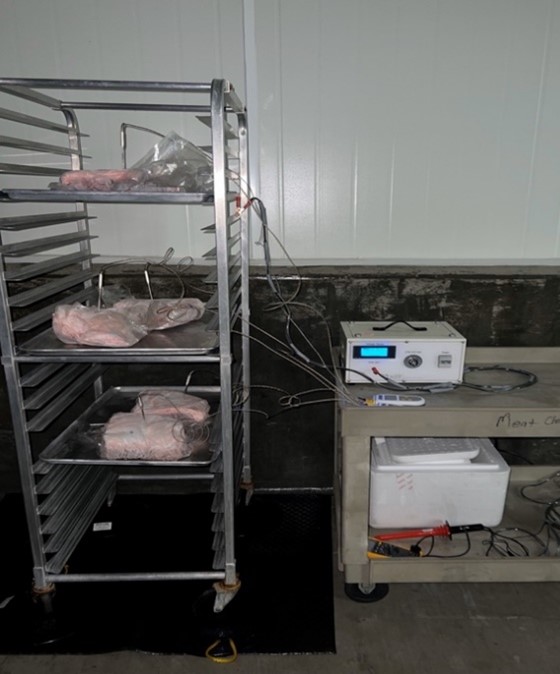Project Summary
A Novel Approach to Using Electrostatic Field to Reduce Thawing Time and Improve Beef Quality
- Principle Investigator(s):
- Grace E. Corrette1, Haley J. Jeneske1, Linnea A. Rimmer1, Larissa A. Koulicoff1, Sara Hene1, Morgan D. Zumbaugh1, Travis G. O’Quinn1, Scott J. Eilert2, Bret Flanders3, Michael D. Chao1
- Institution(s):
- 1Department of Animal Sciences and Industry, Kansas State University
- 2Customer Technical Lead, Cargill
- 3Department of Physics, Kansas State University
- Completion Date:
- August 2023
Key Findings
- Application of 10 kV EF improved beef tenderness.
- Application of EF demonstrated ability to reduce microbial load in beef.
- Application of EF showed a color stabilizing effect during retail display of beef.
- Application of EF did not improve thawing times nor reduce purge loss.
background
Freezing is a common method of cold chain management to extend the shelf-life of beef. However, the thawing process of frozen beef usually results in increased purge loss due to cell membrane damage from the ice crystal formation and is thus viewed as an inferior product compared to fresh beef. Therefore, the beef industry is actively seeking new technologies with the goal of mitigating the negative impacts of freezing. Electrostatic field (EF) assisted thawing is an emerging technology that relies upon applying an alternating current EF during thawing, which functions by oscillating the positive and negative ions in the ice crystals and thus potentially breaks apart the existing ice crystals into smaller and more uniform ice crystals. Based on this existing knowledge, we hypothesize that during the EF thawing process reduces the physical damage of the cellular structure as the ice crystals gradually and uniformly reduce in size throughout the frozen meat.
The objectives of the study were:
1. To develop and establish the parameters for an EF assisted thawing method that can mitigate the adverse impacts of conventional freezing and thawing.
2. To characterize the effect of applying EF on thawing speed, yield (purge loss), microbial growth and beef quality for future applications to the beef industry.
3. To better understand the effect of EF assisted thawing on the subsequent aging effect and myofibrillar protein degradation in beef.
methodology
Striploins from both sides of USDA Choice carcasses (n=12) were collected and portioned into 4 equal parts (n=48). Portions were vacuum packaged and frozen at -20°C for 14 days and randomly assigned to one of 4 EF thawing treatments (figure 1): 0 kV voltage (control), 2.5 kV voltage (EF-2.5), 5 kV voltage (EF-5), and 10 kV voltage (EF-10). Within each EF treatment, half of the striploin portions were thawed in the inside cooler (0°C) and half in the outside cooler (2°C). Internal temperatures were recorded throughout the thawing process, and the thawing process was considered complete when all striploin portions reached -1°C. After thawing, striploin portions were weighed and purge was collected for microbial and protein analysis, and portions were fabricated into steaks. One steak was immediately cored parallel to muscle fiber direction for later histological analysis to assess muscle fiber damage. The remaining steaks were vacuum packaged and subjected to either 0 or 14 days of aging. After the designated aging, steaks were overwrapped and placed in a coffin-style retail case for a designated 0- or 7- days retail display and were evaluated daily for objective color as well as subjective evaluation of discoloration through trained panelists. After completion of each designated aging and display period, steaks were utilized for Warner-Bratzler Shear Force (WBSF), sarcomere length, lipid oxidation (TBARS), proximate analysis, and myofibrillar protein degradation analysis.
results and discussion
There was an increase in purge loss for all EF samples regardless of voltages compared to the control in the outside cooler location (P<0.05). Furthermore, application of EF did not reduce thawing times (P>0.05), with EF-10 taking longer to reach the targeted -1°C than the rest of the treatments (P<0.05). All EF treatments significantly reduced purge aerobic plate count (P<0.01), but only in the outside cooler location. The EF-10 had lower WBSF (P<0.05) compared to the control. EF-10 samples from the outside cooler location tended to have greater muscle fiber spacing compared to the other EF treatments (P=0.09). There were no differences were found for troponin-T degradation, sarcomere length and purge protein concentrations (P>0.05) For the 0-days aged samples, EF-5 on day 7 resulted in more discoloration than the rest of the treatments (P<0.05). Interestingly, when looking at the 14 days aged samples, EF-5 as well as EF-2.5 had less discoloration than the control and EF-10 (P<0.05). When looking at the impact of EF on a*, EF-5 had higher a* values than control and EF-2.5 on days 4 and 5 of retail display (P<0.05). Finally, EF-5 aged for 14 days showed overall higher a* and b* values compared to all other treatments (P<0.05). Lipid oxidation increased over display as expected (P<0.05); however, none of the EF applications or aging periods altered the lipid oxidation of the samples (P>0.10). Finally, applying EF during thawing did not affect: crude protein %, fat %, and moisture % of the samples (P>0.10).
industry Implications
Overall, the application of EF during thawing did not reduce purge loss and thawing times, but the EF-10 treatment yielded a more tender product, which could likely be explained by the oscillating ions from the voltage elevating muscle structural damage. Application of a moderate EF intensity displayed potential to be used a color stabilizer during retail display without affecting other characteristics such as moisture and pH, particularly for EF-5. Along with the impacts on meat color preservation, future research should investigate the impact of EF thawing as an antimicrobial intervention as well as color stabilizer.

Figure 1. A representative image of the experiment set up using the electrostatic thawing system which consists of the electrostatic field (EF) generator (right) and the meat cart containing 6 striploins halves (left).